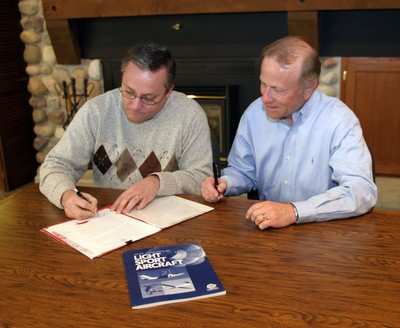Manufacture of S-LSA and E-LSA kits now one step closer to
reality
The FAA has accepted the first industry-developed consensus
standards for light-sport aircraft. This brings the reality of
ready-to-fly special light-sport aircraft (S-LSA) and experimental
light-sport aircraft (E-LSA) kits one step closer.
John Hickey, FAA's
director of aircraft certification services, signed the Notice of
Availability (NOA) for more than a dozen standards required for the
manufacture of various light-sport aircraft (pictured
below). Hickey and other high-level FAA officials were at EAA
Headquarters on Feb. 16-17 for long-range planning meetings with
EAA staff.
"It gives me great pleasure to sign this acceptance at EAA
headquarters, where so much work has been dedicated to making the
sport pilot/light-sport aircraft rule and its implementation a
reality," Hickey said to EAA president Tom Poberezny and those
attending the planning session.
ASTM International's F-37 Light-Sport Aircraft Committee, which
includes representatives from throughout the aviation community,
developed the consensus standards over a more than two-year period.
Official notification of the acceptance will be printed in the
Federal Register during the week of February 21-25, 2005.
"This is a historic moment, not only because it moves the
manufacture of light-sport aircraft one step closer, but also
because it is the first time FAA has accepted industry-developed
standards in lieu of federal regulatory standards for the design
and manufacture of aircraft," said Earl Lawrence, Chairman of
ASTM's F37 light-sport aircraft committee.
"For those individuals
who were concerned that FAA might not keep its commitment to accept
the ASTM standards, worry no more. The work done to date has
officially been approved."
FAA also accepted two standards for gyroplanes and three
standards for lighter-than-air craft. In addition, two non-required
standards were also accepted: airframe emergency parachutes and
engine design and manufacture.
"There are no asterisks. These standards are complete," said
Scott Sedgwick, FAA's manager of the Small Airport Directorate and
a member of the sport-pilot rulemaking team. "Manufacturers
can begin finalizing their designs and production plans for S-LSAs
and E-LSA kits."
A standard that still needs to be developed before manufactured
airplane and powered parachute light-sport aircraft (S-LSA) can be
sold is one pertaining to maintenance. That would cover
inspection procedures, identification and recording of major
repairs and major alterations. The maintenance standard is
expected to be released in late March or early April.
Other standards still under development include: Manufacturers'
assembly instructions, which must be completed before light-sport
aircraft kits (E-LSA) can be sold to the public; required standards
for weight-shift trikes; and remaining standards for all other
categories of LSA.
"Getting the final sport pilot/light-sport aircraft was
obviously a major milestone; however, implementation of the rule is
just as important," Poberezny said. "We need to work together
to keep the process moving forward. EAA stands ready to assist in
any way it can."
Jim Ballough, FAA's director of flight standards, echoed
Poberezny's statements and offered FAA's continuing commitment.

"If we do not continue moving implementation of the rule
forward, we will fail the industry and community," he said. "The
FAA team knows that and is committed to implementation."
 ANN's Daily Aero-Linx (04.13.24)
ANN's Daily Aero-Linx (04.13.24) ANN's Daily Aero-Term (04.13.24): Beyond Visual Line Of Sight (BVLOS)
ANN's Daily Aero-Term (04.13.24): Beyond Visual Line Of Sight (BVLOS) Airborne 04.09.24: SnF24!, Piper-DeltaHawk!, Fisher Update, Junkers
Airborne 04.09.24: SnF24!, Piper-DeltaHawk!, Fisher Update, Junkers Aero-News: Quote of the Day (04.14.24)
Aero-News: Quote of the Day (04.14.24) ANN's Daily Aero-Term (04.14.24): Maximum Authorized Altitude
ANN's Daily Aero-Term (04.14.24): Maximum Authorized Altitude



